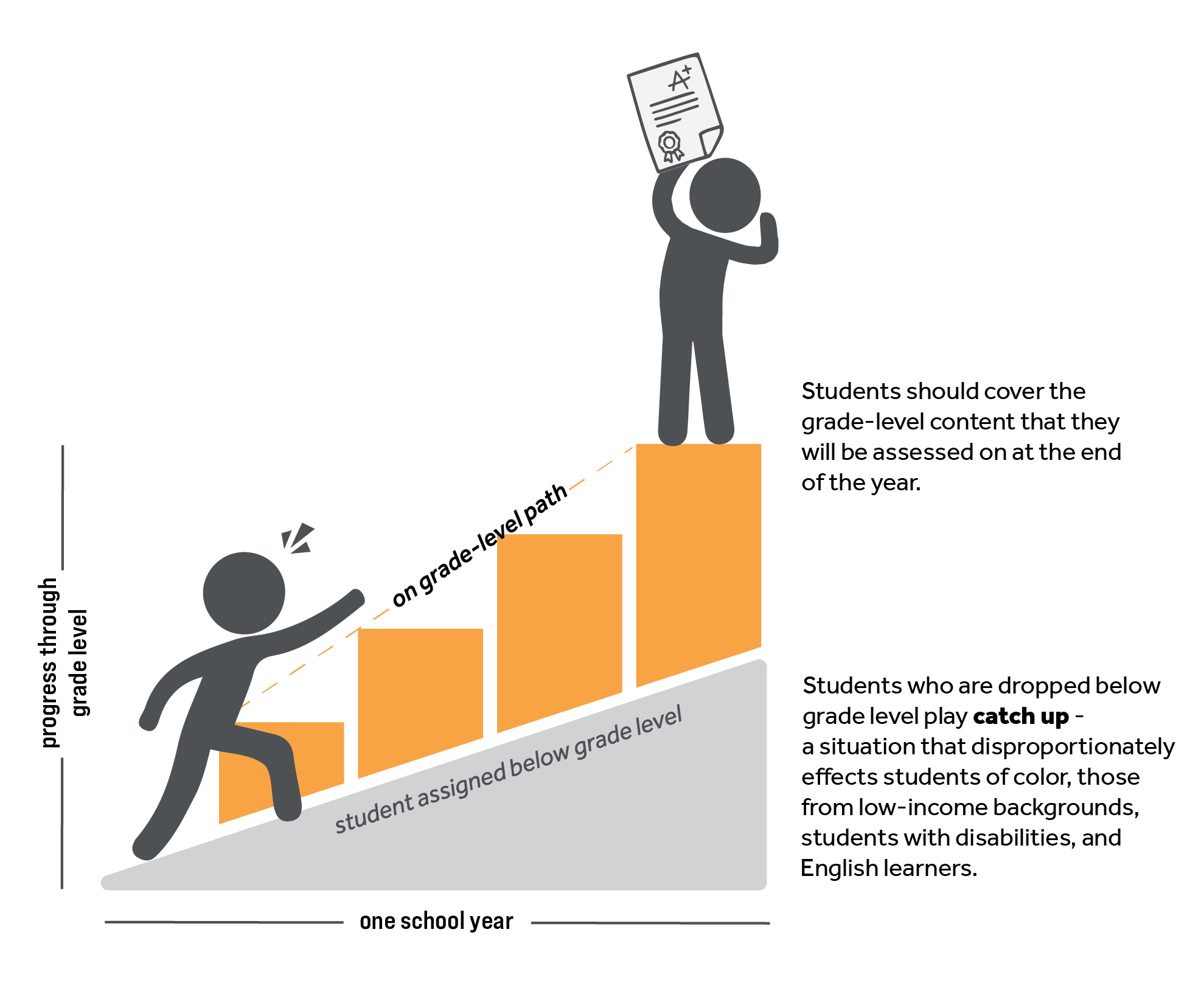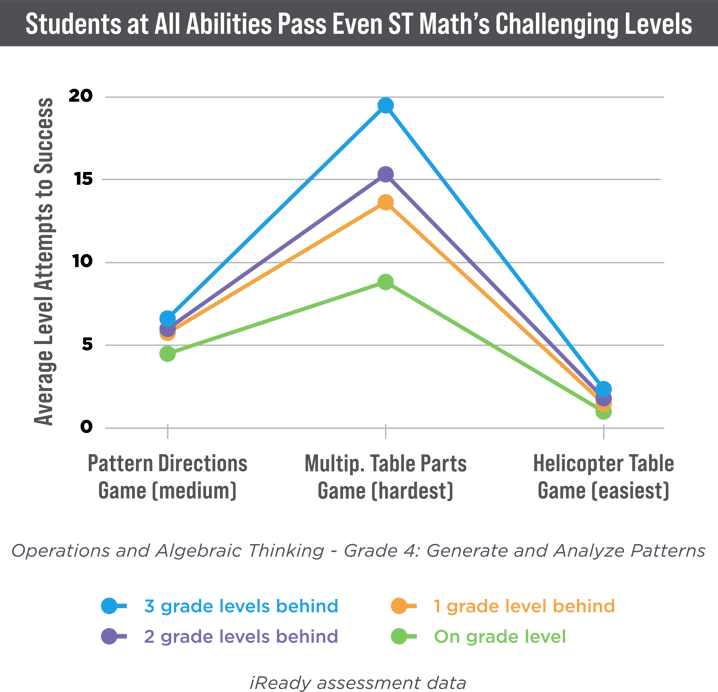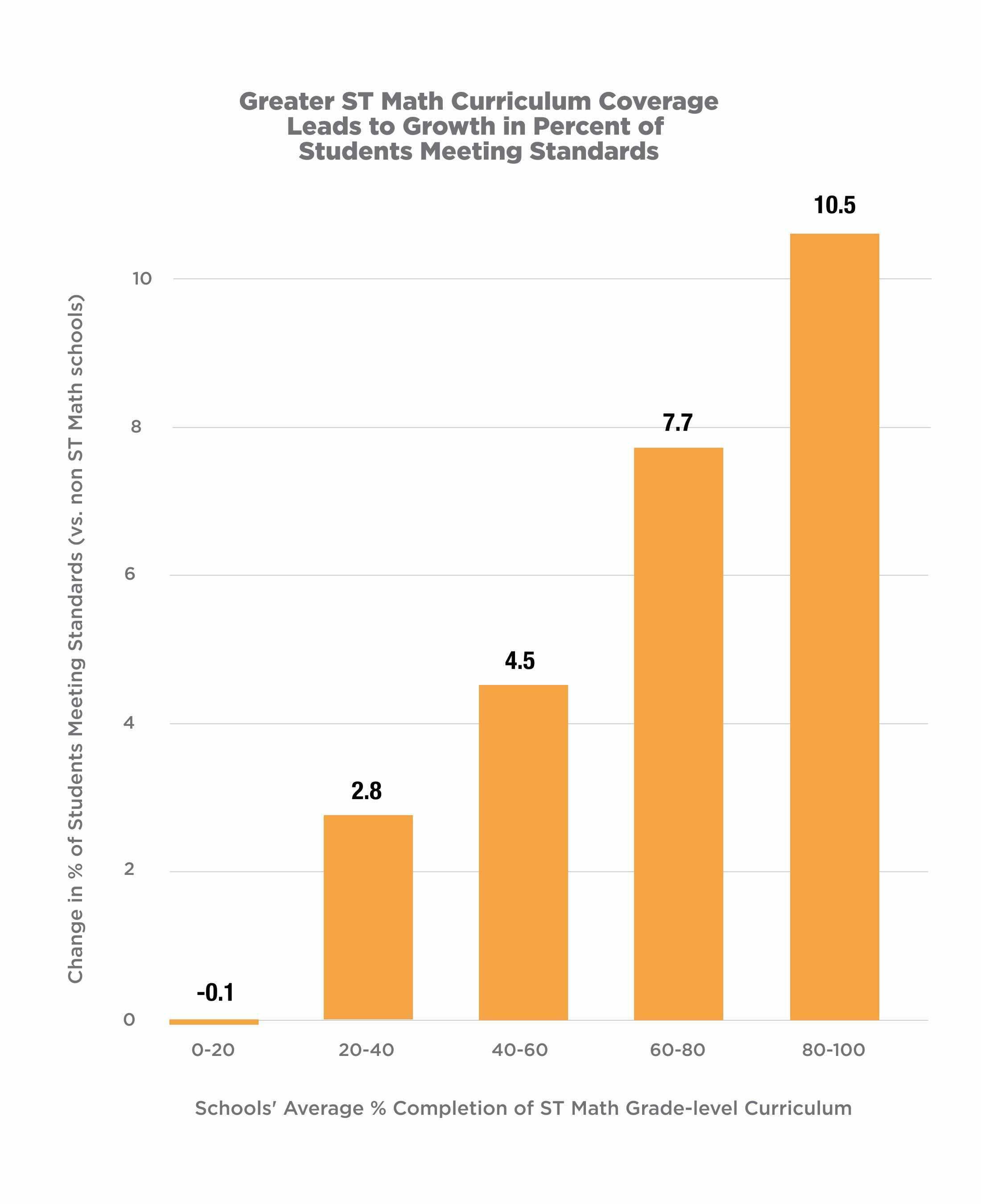
This article features contributions from MIND's Chief Data Science Officer Andrew Coulson.
Teachers often ask to move a student down one or more grade levels in ST Math, based on the student’s state test performance or a universal screener that indicates the student is below grade level in math. While this practice isn’t new, it’s a tempting “easy button” as students return to classrooms and schools everywhere strive to mitigate the effects of the COVID slide.
Yet we know from more than 20 years of field experience in hundreds of thousands of classrooms that students can successfully work through ST Math material at their current grade level, and doing so benefits their performance on summative grade-level assessments. This has recently been validated even for students whose test results indicate they are two or more years behind in math.
 The desire to use a lower grade level of ST Math as a remediation tool is based on a conventional role of supplemental software: for some students, and on some content. But it relies on several false assumptions:
The desire to use a lower grade level of ST Math as a remediation tool is based on a conventional role of supplemental software: for some students, and on some content. But it relies on several false assumptions:

Researchers at Proving Ground, part of the Center for Education Policy Research at Harvard University, specifically looked at whether having students with low math proficiency start with the previous grade’s ST Math content would help bring them up to grade level. Specifically, the researchers provided some students with a “ramp-up” curriculum, featuring select, key elements of the previous grade’s ST Math puzzles, with the hope that they would complete the ramp-up then move on to the beginning of their on-grade-level content, and move through it more quickly. But according to Ethan Scherer, the senior researcher at Proving Ground who oversaw the study, that did not work.
“Moving students to lower grade levels does not speed up their on-grade-level ST Math progress, since most students never reach the on-grade-level games”
—Ethan Scherer, senior researcher, Proving Ground, Center for Education Policy Research, Harvard University
This does not mean that teachers cannot or should not strategically assign specific content from a previous grade level to support and further scaffold on-grade level lessons. (For specific recommendations, see Addressing the Covid Slide with ST Math.) But, importantly, time spent on a lower grade level of ST Math is not time that students get back, and it does not necessarily equate to moving more quickly through on-grade-level ST Math. It’s worth being thoughtful and selective about what gets assigned from a previous year.
You may be wondering how it’s possible to put a student on grade level for ST Math, even if they are testing multiple grade levels below. The answer is in the ST Math puzzles’ intentionally easy entry points, or low floor. The first puzzles in any game are fairly easy, and gradually grow increasingly difficult. Our game designers carefully level every game through repeated analysis of the full gamut of our nationwide user base — classrooms and students from a wide range of backgrounds. The goal is to ensure games are achievable for students who may be below grade level in math, while also challenging even the most advanced students.
In one recent analysis, a school district in the Southwest used iReady to determine their 4th graders’ math grade proficiency. Most of their students tested below grade level: 41% were equivalent to 3rd grade, 21% 2nd grade and 10% 1st grade.
You need to know this about ST Math: the games require mastery to pass. Each difficulty level within a game needs to be solved fully and correctly — a puzzles solved score of 100%. Just like any other video game, however, students get as many attempts as they personally need. And just like a video game, each attempt provides them visual information as to why they failed and what needs to change to pass.
We looked at how many times students in each of those groups had to play ST Math games to achieve mastery. As you may expect, the further below grade level students were, the more attempts they needed with each game before achieving mastery. They didn’t already know the math, and they needed to learn. For example, a student testing on grade level (4th grade) might master a difficult 4th grade ST Math level with fewer than five tries. Students testing as far below as 1st grade level showed that they could also master the same challenging 4th grade content, too. It just took them longer — averaging 20 attempts. But, critically, regardless of assessed “equivalent math grade level,” all students in the classrooms did eventually master the levels.

This type of data helps ST Math game designers find the sweet spot for game difficulty. If students never fail any game level, it’s too easy to be fun. ST Math should be showing them something new about the math — and learning something new means getting things wrong from time to time. On the other hand, designers want to keep the number of tries to a reasonable level for students — too much repeated failure can eventually get unproductive.
“ST Math really is good for all kids,” says Meagan Erwin, a 1st grade teacher in Columbus, Ohio, who has used the program for eight years, with both 1st and 3rd grade students, including students in special education and gifted and talented programs. “With the scaffolding inherent in ST Math’s design, every student can get through at least level one of each game. Even my struggling kids feel enough success with that to get excited and keep going.”
When all students build a tolerance for challenge and struggle, they earn confidence in their abilities, and they develop perseverance. One of the benefits of ST Math is that it offers ample opportunities for productive struggle. One of the mistakes teachers can make in their effort to develop perseverance in students is to give them easier work when they see their students struggling. (See 8 Teaching Habits that Block Productive Struggle in Math Students.)
Instead of trying to eliminate struggle, make a point of celebrating when a student has been working long and hard at mastering a level. Did it take them 20 tries? Wow! Celebrate their perseverance and accomplishment. They truly earned it. Not every student will work at the same pace or in the same way, but they can all have their hard work celebrated and learn to believe in themselves.
Further research from Proving Ground found that for every 10 additional minutes a student spends on ST Math, there is a measurable improvement in grade-level proficiency on standardized math tests. So while lower-performing students will take more time, we also already know that giving students more time on ST Math means greater proficiency, and better test scores.

(Learn more about ST Math’s Theory of Change in this podcast episode.)
This is even more important for those students who persevere through more attempts to master a level. It can take up to 100 hours for a student who moves at a slower pace to get through the full richness of an entire grade level of ST Math — more than twice as much time as the recommended average target of 90 minutes a week.
“It’s definitely a challenge,” says Erwin. “Although it takes some students longer to get through levels, the pride they feel when they complete a level that they’ve worked hard at, makes it worth it.”
Erwin suggests students who need more time on ST Math might find extra minutes during class enrichment time, or right at the beginning of the day, when students first arrive at school.
What’s more, a silver lining of the COVID-19 pandemic is that more students than ever before have one-to-one devices and internet connections at home. Assigning ST Math as homework is an increasingly appealing option.
Think about reading: if the class is reading a novel, are the slower readers excused from finishing the chapters assigned that week? Or would you ask them to finish reading it at home? ST Math can be treated the same way, not as a set number of minutes to complete, but for each student to take as long as they need to complete the work assigned.
If you’re still uncertain about the crucial value of keeping students on grade level in ST Math, consider TNTP’s research presented in their report, the Opportunity Myth. Too often, they found that students face long-term harm from low expectations and below-grade-level content. The problem is even worse among students of color, those from low-income backgrounds, students with disabilities, and English learners.
In fact, TNTP found that three-quarters of the time students spent in class was used working on assignments below grade level. That lost time hurt students in the short term, and down the road, for example when they went to college and found themselves required to take remedial classes in subjects they thought they had mastered. Overall, TNTP found that students make greater learning gains when their teachers hold high expectations about their ability to meet grade-level standards.
When students who started the year behind had greater access to grade-appropriate assignments, they closed the outcomes gap with their peers by more than seven months.
Simply put, students deserve to be given their grade-level content. ST Math is specifically designed so that all students — whether they are in special education or gifted & talented programs — can experience both productive struggle and on-grade-level success. It takes longer for some students, and that’s OK. Every student deserves an equitable opportunity for on-grade-level learning and growth.
Comment